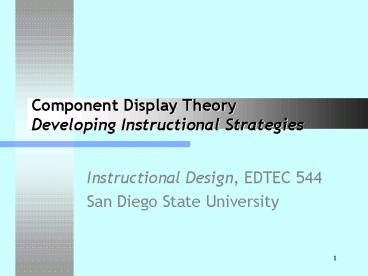Component Display Theory Developing Instructional Strategies PowerPoint PPT Presentation
1 / 23
Title: Component Display Theory Developing Instructional Strategies
1
Component Display TheoryDeveloping Instructional
Strategies
- Instructional Design, EDTEC 544
- San Diego State University
2
On The Horizon.
- Classification of knowledge and learning outcomes
- Declarative vs. Procedural knowledge
- Automaticity
- Novice and Expert Performance
- Blooms Taxonomy of Learning Outcomes
- Gagnes Taxonomy Conditions of Learning Theory
- Metacognition
- Merrills Component Display Theory
- The content-performance matrix
- Cognitive task analysis knowledge mapping
3
Conditions of Learning
- Learning can be classified into categories or
domains - Verbal Information
- Attitudes
- Intellectual Skills
- Motor Skills
- Cognitive Strategies
- For the various types of outcomes to occur, we
must establish different sets of conditions - The acquisition of these outcomes requires
different internal (cognitive activity for
learning) and external conditions of learning
(external instructional events)
4
Conditions-based Perspective
- The influence of the conditions-based perspective
can be found in task analysis, strategy
development, and evaluation procedures of
conditions-based instructional design models.
Examples of conditions-based instructional design
models
Gagne (1985) The Conditions of Learning, 4th
edition Gagne, Briggs, and Wager (1988)
Principles of Instructional DesignMerrill (1983)
Component Display Theory Reigeluth (1979)
Elaboration TheoryMerrill, Li, Jones (1990)
ID2, Transactional theory
5
Development of instructional strategies
- According to conditions-based models, when
designing instructional strategies, instructional
designers must - determine the goals of the instruction,
- categorize these goals as to outcome category,
and - select strategies that have been suggested as
being effective for this category of learning
outcome.
6
Assumptions of conditions-based models
- Learning outcomes can be represented in a
predictable prerequisite relationship - Acquisition of different outcome categories
require different internal processes - Different internal processes are supported by
different instructional processes
7
Merrill Component Display Theory (CDT)
- CDT is an extension of Gagnes theory.
- CDT is founded on the same assumptions as Gagnes
work - Conditions-based theory of instructional design
he prescribed instructional conditions based on
types of learning outcomes desired.
8
Merrills Component Display Theory (CDT)
- Component Display Theory (CDT) classifies
learning along two dimensions - content (facts, concepts, procedures, and
principles) and - performance (remember, use, find).
- The theory specifies four primary presentation
forms - Rules, examples, recall and practice.
- Secondary presentation forms include
prerequisites, objectives, helps, mnemonics, and
feedback.
9
Merrills Component Display Theory
- http//tip.psychology.org/index.html
10
Content-Performance Matrix
Fact Concept Process Procedure Principle
Classify new examples Solve a problem, Make an inference Perform Solve a problem, make and inference
Remember Remember the definition Remember the stages Remember the steps Remember the guidelines
Use/Apply
Remember
11
Instructional Conditions
- Merrill does not address the internal processes
that accompany the acquisition of each of these
categories of learning types. - External conditions Presentation forms
- Merrill described instructional conditions as
presentation forms and classified these forms
as primary and secondary presentation forms.
12
Primary Presentation Forms
- Primary presentation forms provide the basic
building blocks for the instructional strategies - They have two dimensions
- content (generality or instance)
- approach (expository or inquisitory)
13
(No Transcript)
14
Instructional Sequences
- Two instructional sequences in CD
- Expositional and Inquisitory
- During an expositional instructional sequence the
instructor presents information to the students - During an inquisitory instructional sequence the
instructor asks students about the information
15
Primary presentation forms (Cont.)
- Expository Generality (EG) - present the main
idea - Inquisitory Generality (IG) - ask them about the
main idea - Expository instance (Eeg) - present an example of
the main idea - Inquisitory instance (Ieg) - ask them about an
example - Expository Fact (EF) - present a fact
- Inquisitory Fact (IF) ask them about a fact
16
Primary Types of Information Presentation Forms
Types/Level of Information Present the Information Ask Information
GeneralityConcept, Process, Procedure, Principle Present the main idea Ask a question about the main idea
Instance Present example or non-example Ask question about example or non-example
FACTS Present a fact Ask question about the fact
17
Secondary presentation forms
- SPF are types of elaborations that may extend the
primary presentations - provide supportive information that helps
learners to interpret and understand information
in the PPFs. These components - explain terms or components in the generality
- relate generalities to specific examples
- provide analogies
- provide alternative representations of examples
or generalities (such as diagrams) - supply a context for examples or generalities
- provide correct answer or detected answer
feedback to learners about their responses
18
(No Transcript)
19
Tertiary Presentation Forms
- Tertiary Presentation Forms provide additional
information or guidance not directly related to
Primary and Secondary Presentation Forms.
20
(No Transcript)
21
Example 1
- The Sandwich Crème Cookie
- http//coe.sdsu.edu/EDTEC544/Modules/9-CDT_Develop
ingInstStrategies/r/reflect.htm
22
Example 2
- If we were designing a lesson according to the
CDT, it would have the following minimum
components - Objective - (Remember or Apply)
- Generality - Definition (attributes,
relationships) - Instance - Examples (attributes present,
representations) - Generality Practice - State definition
- Instance Practice - Classify (attributes present)
- Feedback - Correct generalities/instances
- Elaborations - Helps, Prerequisites, Context
23
Comments
- Building blocks type of guidelines
- provide a good reference for instructional
content ideas, and - a useful list as the system is being designed.
- The training program is not be effective simply
because it contains each type of information unit.

